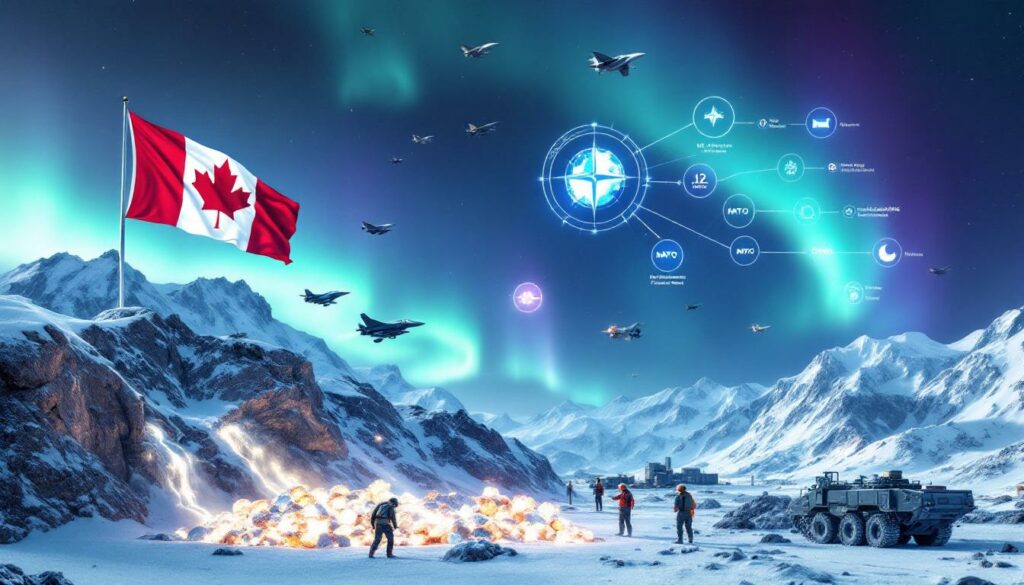What Are Strategic Minerals and Why Do They Matter for Defence?
Strategic minerals are essential raw materials required for advanced military equipment and technologies. These minerals possess unique properties that make them irreplaceable in critical defence applications. NATO has identified 12 critical raw materials essential for defence, all of which can be found within Canadian borders.
The strategic importance of these minerals stems from their limited global availability and vulnerability to supply chain disruptions during geopolitical conflicts. As the Business Council of Canada stated, "Canada should become a world leader in producing and processing raw materials for military equipment and defense systems."
The Critical Connection Between Minerals and Military Technology
Defence applications for these minerals are extensive and essential:
- Cobalt (found in Newfoundland and Labrador): Critical for high-performance jet engines, missile components, and rechargeable batteries
- Graphite (found in Quebec): Used in electronics, lubricants, and stealth technology
- Platinum (found in Ontario): Essential for fuel cells, sensors, and catalytic systems
- Germanium (found in British Columbia): Critical component in night vision equipment, infrared optics, and fiber optic systems
These materials are not simply beneficial—they're irreplaceable. The unique electronic, thermal, and structural properties of these minerals cannot be substituted with alternative materials without significant performance degradation in military systems.
"The world has changed—and if we play our cards right, it may be changing in Canada's favor," notes the Business Council of Canada's recent report "Selling to our strengths."
Why Canada Needs a Strategic Minerals Reserve
Canada currently faces significant vulnerabilities in its defence supply chains. The global market for strategic minerals is characterized by volatility, with prices fluctuating dramatically in response to geopolitical events. Many critical minerals for energy security are sourced from politically unstable regions or countries that may impose export restrictions during conflicts.
Current Vulnerabilities in Defence Supply Chains
Recent global events have highlighted how quickly access to critical minerals can be restricted. Export controls and limited inventories threaten continuous access to these essential materials. The Business Council of Canada has identified that "Canada lacks the export infrastructure to fully leverage its natural assets" despite possessing all the necessary raw materials.
This vulnerability extends beyond simple supply disruptions. Processing capabilities for many critical minerals are concentrated in a limited number of countries, creating potential bottlenecks in the defence manufacturing supply chain. A strategic reserve would help mitigate these vulnerabilities by ensuring a stable domestic supply.
Economic and National Security Benefits
A strategic minerals reserve offers dual benefits:
- Security enhancement: Ensuring continuous access to materials essential for defence manufacturing during supply disruptions
- Economic opportunity: Stimulating domestic mining and processing industries
As the Business Council of Canada noted, "Canadians are no better off today than they were a decade ago," pointing to the untapped potential of the country's natural resources. By establishing a strategic minerals reserve, Canada can address both economic and security challenges simultaneously.
The reserve would help "allies lock in a stable supply of key materials" while creating high-value jobs in mining, processing, and manufacturing sectors. This initiative aligns perfectly with Canada's goal of reducing dependency on foreign suppliers for critical defence inputs.
How Would a Canadian Strategic Minerals Reserve Work?
The Business Council of Canada has proposed a collaborative model where the Canadian government would work with NATO allies to establish a dedicated reserve of defence-critical minerals. This "critical mineral reserve for defense technology and military purposes" would ensure stable supply for both domestic and allied defence manufacturers.
Proposed Structure and Governance
The reserve would likely function under a public-private partnership structure with:
- Government oversight: Ensuring strategic alignment with national security objectives
- Industry expertise: Guiding operational aspects of acquisition, storage, and distribution
- NATO collaboration: Sharing costs and responsibilities among alliance members
This structure would balance security imperatives with economic efficiency, ensuring taxpayer value while meeting critical defence needs. The reserve would maintain predetermined inventory levels of processed and semi-processed minerals ready for rapid deployment to defence manufacturers.
Stockpiling Strategies and Inventory Management
Effective management of a strategic minerals reserve requires sophisticated inventory strategies that balance security needs with economic considerations:
- Criticality assessment: Determining optimal stockpile levels for each mineral based on defence applications and supply risk
- Rotation protocols: Preventing material degradation through systematic renewal
- Market-responsive acquisition: Timing purchases to minimize costs while ensuring adequate supplies
These approaches would help the reserve function not as a static stockpile but as a dynamic buffer against supply disruptions, responsive to changing defence technology needs and global market conditions.
Canada's Unique Position in the Global Minerals Landscape
Canada possesses extraordinary geological advantages that position it ideally for leadership in strategic minerals. The country has deposits of all 12 NATO-critical minerals within its borders, distributed across multiple provinces and territories.
Geological Advantages and Resource Potential
The Canadian Shield and other geological formations contain substantial deposits of nearly all NATO-critical defence minerals:
- Rare earth elements: Essential for precision-guided weapons and communications equipment
- Titanium: Used in aircraft structures and armor plating
- Vanadium: Critical for high-strength steel alloys used in military vehicles
Recent geological surveys have identified previously unrecognized reserves across multiple provinces, enhancing Canada's potential as a strategic minerals powerhouse. These discoveries suggest that Canada's mineral wealth may be even greater than previously estimated.
Existing Mining Infrastructure and Expertise
Canada's century-long mining tradition has created world-class expertise and infrastructure that can be leveraged for strategic minerals development. The country's mining sector employs hundreds of thousands of workers and contributes significantly to GDP, providing a strong foundation for expanding into defence-critical mineral production.
Existing mining communities across the country offer skilled workforces ready to support expanded operations. As the Business Council of Canada stated, Canada should "become a world leader in producing and processing raw materials" for defence applications.
How a Strategic Minerals Reserve Aligns with Current Canadian Policy
The proposed strategic minerals reserve aligns perfectly with Canada's evolving defence and resource policies. Under Prime Minister Mark Carney, who took office in March 2025, Canada has demonstrated a renewed commitment to both defence capabilities and resource development.
Integration with Critical Minerals Strategy
The defence minerals reserve would represent a specialized extension of Canada's existing Critical Minerals Strategy, with particular emphasis on materials essential for military applications and NATO commitments.
This integration would allow for coordinated policy approaches, shared infrastructure, and synergistic development of mining and processing capabilities for both civilian and military applications.
Support for Increased Defence Spending Commitments
In June 2025, Canada announced an immediate increase to its defence budget to meet NATO's target of spending 2% of GDP on defence. A strategic minerals reserve directly supports this commitment by ensuring the materials needed for expanded defence manufacturing and procurement are readily available.
This initiative "fits with Canada's greater focus on military spending under Prime Minister Mark Carney," as noted by Mining Weekly. The reserve would enhance the effectiveness of increased defence spending by addressing potential supply chain bottlenecks that could otherwise limit manufacturing capacity.
International Collaboration Opportunities
The strategic minerals reserve concept is inherently collaborative, recognizing that mineral security is a shared challenge across Western democracies. The Business Council's proposal specifically calls for Canada to "work with other NATO members" to create this reserve.
NATO Alliance Coordination
Collaboration with NATO allies would allow for:
- Burden-sharing: Distributing acquisition costs among alliance members
- Coordinated stockpiling: Optimizing inventory levels across national reserves
- Mutual access agreements: Ensuring all allies benefit from collective mineral security
This approach recognizes that no single NATO member can achieve complete mineral independence, but through collaboration, the alliance can significantly reduce collective vulnerability to supply disruptions.
Partnerships with Five Eyes Nations
Beyond NATO, Canada has natural collaboration opportunities with Five Eyes intelligence alliance partners (US, UK, Australia, New Zealand). These nations share similar security concerns and have complementary mineral resources, creating possibilities for coordinated stockpiling strategies.
Australia, in particular, has developed sophisticated approaches to defence critical materials strategy that could inform Canada's strategy. By leveraging these relationships, Canada can enhance both the effectiveness and efficiency of its strategic minerals reserve.
Implementation Challenges and Solutions
Establishing a strategic minerals reserve presents significant challenges that must be addressed through thoughtful policy design and stakeholder engagement.
Funding Models and Initial Investment Requirements
Various funding approaches could be considered:
- Dedicated defence budget allocations: Direct government funding tied to national security objectives
- Public-private partnerships: Industry contributions to stockpiling in exchange for guaranteed access
- Innovative financing: Mineral security bonds or other financial instruments to distribute costs
The optimal approach likely involves a combination of these mechanisms, ensuring sustainable funding while distributing costs appropriately between public and private sectors.
Environmental and Indigenous Considerations
Any expansion of mineral production must address environmental impacts and respect Indigenous rights. Modern approaches to strategic reserves can:
- Incorporate strict environmental standards for sourced materials
- Prioritize minerals from operations with exemplary environmental practices
- Develop meaningful partnerships with Indigenous communities
By integrating these considerations from the outset, Canada can develop a strategic minerals reserve that aligns with broader sustainability and reconciliation objectives.
Economic Impact and Growth Opportunities
A strategic minerals initiative would create significant economic benefits across multiple sectors and regions of Canada.
Job Creation and Regional Development
The initiative would stimulate growth in:
- Mining operations: Direct extraction and processing jobs
- Technical services: Geological assessment, environmental monitoring, and quality control
- Logistics and security: Transportation, storage, and protection of strategic materials
Many of these opportunities would benefit rural and remote communities where mineral deposits are located, supporting regional development goals and providing economic diversification in resource-dependent areas.
Value-Added Processing and Manufacturing
Rather than simply stockpiling raw materials, a sophisticated strategic minerals approach would emphasize development of domestic processing capabilities. As the Business Council noted, Canada can "get what we have to those who want it—in a way that increases both economic security and economic growth."
This "value-added" approach would:
- Create higher-paying technical jobs in processing facilities
- Reduce dependency on foreign processors for critical materials
- Position Canada as an exporter of processed defence materials to allies
By focusing on the entire value chain—from extraction to processing to manufacturing—Canada can maximize the economic benefits of its mineral wealth.
What Industry Leaders Are Saying
The Business Council of Canada, representing the country's largest employers and most influential executives, has articulated a bold vision for mineral security in its report "Selling to our strengths."
Business Council of Canada's Vision
The Business Council has identified several key points regarding Canada's strategic minerals potential:
"Canadians are no better off today than they were a decade ago."
This sobering assessment highlights the urgency of developing new economic opportunities, including strategic minerals.
"Canada lacks the export infrastructure to fully leverage its natural assets and deliver to allies and trading partners the commodities they need and want."
This points to the need for investment in processing and transportation infrastructure to fully capitalize on Canada's mineral wealth.
"The world has changed—and if we play our cards right, it may be changing in Canada's favor."
This optimistic note suggests that global geopolitical shifts have created a unique opportunity for Canada to emerge as a leader in strategic minerals.
Expert Perspectives on Implementation Timeline
Industry experts suggest that a properly structured strategic minerals reserve could be operational within 3-5 years, with initial stockpiling of the most critical materials possible in even shorter timeframes.
Mining executives emphasize that many required minerals are already being produced in Canada but are currently exported for processing, creating an opportunity for rapid development of domestic value chains. By focusing initially on these existing production streams, Canada could establish the foundation of a strategic reserve relatively quickly.
FAQ: Strategic Minerals Reserve for Defence
What specific minerals would be included in a Canadian strategic reserve?
A Canadian strategic minerals reserve would prioritize the 12 NATO-identified critical minerals essential for defence applications:
- Cobalt (jet engines, batteries)
- Graphite (electronics, lubricants)
- Platinum (fuel cells, sensors)
- Germanium (night vision equipment, fiber optics)
- Rare earth elements (precision guidance systems)
- Titanium (aircraft structures)
- Vanadium (high-strength steel alloys)
- Tungsten (armor-piercing ammunition)
- Beryllium (aircraft components)
- Gallium (radar systems)
- Magnesium (lightweight alloys)
- Silicon metal (electronics)
The specific stockpiling targets would be determined through a comprehensive assessment of defence manufacturing requirements and supply chain vulnerability analysis.
How would this initiative affect Canadian taxpayers?
While establishing a strategic minerals reserve would require initial government investment, the long-term economic benefits could offset these costs. The initiative would create jobs, stimulate regional development, and potentially reduce defence procurement costs by stabilizing material prices and ensuring supply chain security.
Various funding models could be employed to minimize direct taxpayer impact, including public-private partnerships and cost-sharing with NATO allies. The Business Council of Canada's proposal emphasizes the dual economic and security benefits, suggesting that the reserve could become self-sustaining over time.
How does this proposal compare to similar programs in other countries?
Several countries maintain strategic mineral reserves, with the US Mineral Production Order being the most comprehensive. China has also developed extensive strategic reserves of critical minerals.
Canada's proposed approach would be distinguished by:
- NATO collaboration: Emphasizing alliance-wide mineral security
- Integration with existing mining expertise: Leveraging Canada's world-class mining sector
- Value-added processing: Focusing on developing domestic processing capabilities rather than simply stockpiling raw materials
These distinctive features would position Canada's strategic minerals reserve as a model for other democratic nations seeking to enhance their mineral security.
The Path Forward: Next Steps for Canada
Moving from concept to implementation will require coordinated action from government, industry, and international partners.
Policy Development and Legislative Framework
The development of a comprehensive policy framework should include:
- Governance structure: Establishing the entity responsible for reserve management
- Funding mechanisms: Securing sustainable financial resources
- Acquisition protocols: Determining how, when, and from whom minerals will be purchased
This process should include broad consultation with defence experts, mining industry representatives, Indigenous communities, and international allies to ensure the reserve meets diverse stakeholder needs.
Industry and Government Collaboration Roadmap
Successful implementation will depend on effective collaboration between government agencies and private sector partners. A structured roadmap should define:
- Roles and responsibilities: Clarifying which entities lead different aspects of reserve development
- Coordination mechanisms: Establishing how decisions will be made and implemented
- Progress metrics: Defining how success will be measured and evaluated
With proper planning and execution, Canada can establish a world-class strategic minerals reserve that enhances national security, strengthens NATO, and creates economic opportunities across the country.
Ready to Capitalise on the Next Major Mineral Discovery?
Stay ahead of the market with real-time alerts on significant ASX mineral discoveries through Discovery Alert's proprietary Discovery IQ model, which transforms complex mineral data into actionable insights for investors interested in defence and strategic minerals. Explore why major mineral discoveries can lead to substantial returns by visiting Discovery Alert's dedicated discoveries page and begin your 30-day free trial today.




